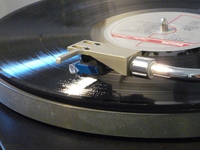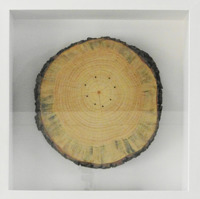Items
Site
The Medicine Chest
keywords is exactly
rings
-

Years
“On regular vinyl, there is this groove that represents however long the track is. There’s a physical representation of the length of the audio track that’s imprinted on the record. The year rings are very similar because it takes a very long time to actually grow this structure because it depends on which record you put on of those I made. It’s usually 30 to 60 or 70 years in that amount of space. It was really interesting for me to have this visual representation of time and then translate it back into a song which it wouldn’t originally be " (Traubeck 2012). This record features seven recordings from different Austrian trees. They were generated on the Years installation in Vienna, January 2012. -

Mozart's Antimony
Medical bedside cabinet, gramophone player with a hypodermic needle substitution, Mozart’s Sonata in C, KV 279 and Sonata in D, KV 576. The needle is slowly scratching irreparable grooves into the record whilst the record in return, is making the needle blunt.. "On 20 October 1791, Mozart told his wife Constanza that he was being poisoned. On 20 November he developed a fever; his hands, feet and stomach became swollen, and he had attacks of vomiting. He died on the 5th of December. Although Antonio Salieri confessed to Mozart’s murder several years later, it is highly unlikely as Salieri suffered from senile dementia. In 1991, Ian James of London’s Royal Free Hospital attributed Mozart’s death to antimony, a poison that Mozart may have been given by his doctor - not to kill him but to cure him. Antimony was prescribed for what was then diagnosed as melancholia. In small doses it leads to headaches, fainting and depression. In large doses it can be fatal within days (Emsley 1999: 225). In the autumn of 1791, Mozart, suffering from severe depression, exacerbated by debt, the ill reception of his new work La Clemenza di Tito, and a commission to write a requiem which he believed was for his own funeral, dosed himself with a variety of medicines – one of these being antimony – and what was meant to cure, killed" (Liebenberg 2011: 85 - 91). -

Timekeeper
Installation view of a hole revealing all painting of successive exhibition layers, 20 cm in diameter at the Viennese Secession -

Forest (process)
A collection of Echinacea angustifolia tea rings read by botanist and dendrochronologist, Dr Edmund February. A molecule found in the Echinacea angustifolia plant prevents a caterpillar on eating it, from ever turning into a butterfly. Example of a specimen reading: “It would appear that the tree stood on a slope since there is more compression on the left hand side, which indicates that side was under less tension. It could also be a branch of which the left hand side would be its underside. The rings are uniformly wide which suggests plenty of soil and moisture availability. In comparison with the other two trees, the outer rings suggest less water or more competition.” -

Forest
A collection of Echinacea angustifolia tea rings read by botanist and dendrochronologist, Dr Edmund February. A molecule found in the Echinacea angustifolia plant prevents a caterpillar on eating it, from ever turning into a butterfly. Example of a specimen reading: “It would appear that the tree stood on a slope since there is more compression on the left hand side, which indicates that side was under less tension. It could also be a branch of which the left hand side would be its underside. The rings are uniformly wide which suggests plenty of soil and moisture availability. In comparison with the other two trees, the outer rings suggest less water or more competition.” -

1975 (Invasive Species)
1975 (Invasive Species) stems from a historical and botanical enquiry. In 1975, after attaining independence from Portugal, the civil war broke out in Angola. In that same year, the South African Defense Force under the authorization of Vorster, intervened in the war – an intervention which formed part of an ongoing period of conflict in South African history, known as the Border Wars. From a botanical point of departure, the cluster pine (or Pinus Pinaster) is native to Portugal. In South Africa it is seen as invasive, competing with and replacing indigenous species. The work consists of a cross section of cluster pine used as a target practice unit, into which the artist shot a ring of R4 assault rifle bullets – aiming at tree ring 1975.


